This fascinating stamp issue holds a special interest for stamp collectors as it was one of the world's earliest pictorial definitive issues.
Issue information
The most startling change brought about by the issue was the departure from the almost universal use of portrait designs of monarchs or presidents to a set of stamps in which every stamp was not only different from the others but generally more attractive and interesting. The advantages from both financial and general points of view had been submitted to the Postmaster-General as early as 1894 for a stamp issue that was “symbolic of the land”.
The stamp designs were selected from around 2,400 entered in a public competition.
H W Young designed the 1/2d stamp, J Gaut the 1d, W R Bock the 2d, 3d, 9d and 1s values, E Howard the 4d, 6d and 8d and E T Luke the 2 1/2d, 5d, 2s and 5s stamps.
The stamps were all engraved by Waterlow and Sons, England. The first issue was also printed by Waterlow and Sons, with later supplies being printed in New Zealand from new plates also supplied by Waterlow and Sons.
Acknowledgments
New Zealand Post would like to acknowledge the following for their assistance and guidance in bringing together this stamp issue:
Historical information included on this page sourced from The Postage Stamps of New Zealand published by the Royal Philatelic Society of NZ. Their web site offers further information useful to those interested in the stamps and postal history of New Zealand. Link: https://www.rpsnz.org.nz/
Product Listing for 1898 Pictorials
| Image | Title | Description | Price |
|---|---|---|---|
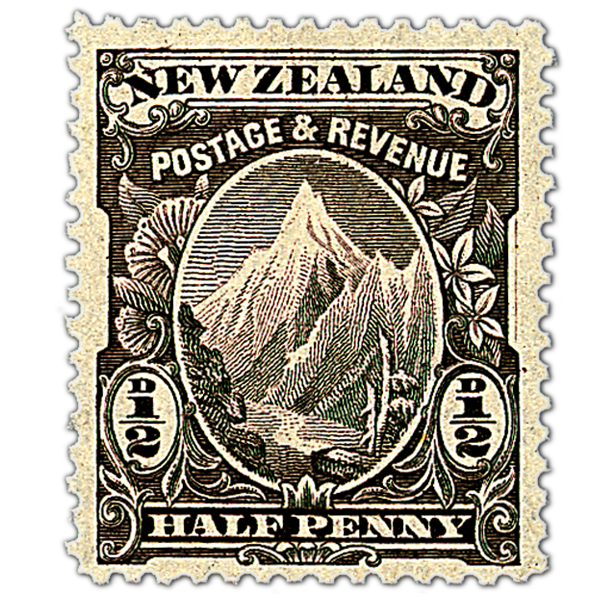 |
Single Stamp |
Single 1/2d 'Mount Cook' gummed stamp. Mount Cook is New Zealand's highest mountain. The mountain ridge runs from the Hooker Glacier on the west side to the Tasman Glacier on the east and forms a section of the South Island's Main Divide. The flowers depicted on the stamp are the ranunculus and celmisia - two varieties of alpine flora. |
1/2d |
 |
Single Stamp |
Single 1d 'Lake Taupo' gummed stamp. Taupo is the name of the largest lake in New Zealand, and of the town in Tapuaeharuru Bay at its north-eastern corner. The lake covers 606 square km, and is 357 metres above sea level in the central North Island. The lake is well known for its boating and for its rainbow trout fishing. The trout were introduced in 1884. Mount Ruapehu (2,797 metres) is illustrated in the background of the design; the tree to the left is a cabbage palm - named by early settlers who ate the head of the plant in place of cabbage. This was New Zealand's first two coloured stamp. |
1d |
 |
Single Stamp |
Single 2d 'Pembroke Peak' gummed stamp. Along the southern extremity of the west coast of the South Island is a series of sounds or fiords of remarkable scenic beauty. Pembroke Peak is situated in Milford Sound, and rises to a height of over 2,100 metres. |
2d |
 |
Single Stamp |
Single 2 1/2d 'Lake Wakitipu' gummed stamp. Wakatipu is the second largest lake in the South Island, after Lake Te Anau, and covers 293 square km. It lies at the southern end of the Southern Alps in Central Otago. Mount Earnslaw (at over 2,400 metres) is depicted in the background of the design, also illustrated, at the left, is New Zealand flax, and, at right, cabbage palms and toitoi. A sheep drover, Nathaniel Chalmers, is believed to have been the first European to sight the lake, arriving there with two Māori guides in 1853. Due to a spelling mistake in the stamp, this was re-issued on the 5th May 1898. |
2 1/2d |
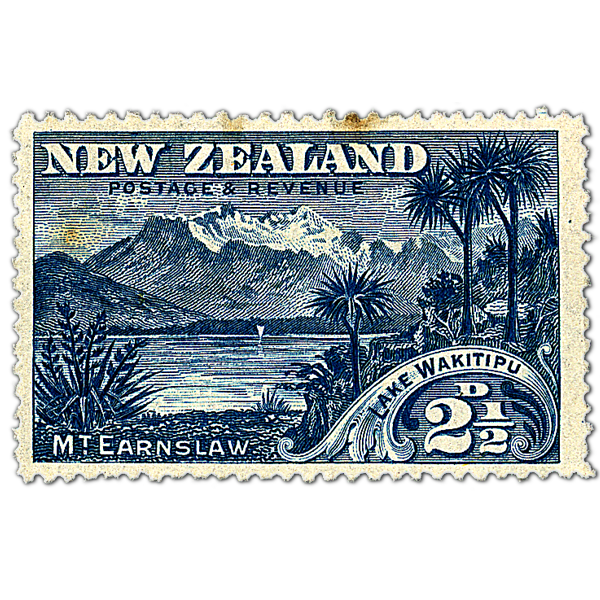 |
Single Stamp |
Single 2 1/2d 'Lake Wakatipu' gummed stamp. This stamp was first issued 5 May 1898, to replace the original 2 1/2d stamp which contained a spelling mistake, "Wakitipu" instead of "Wakatipu". |
2 1/2d |
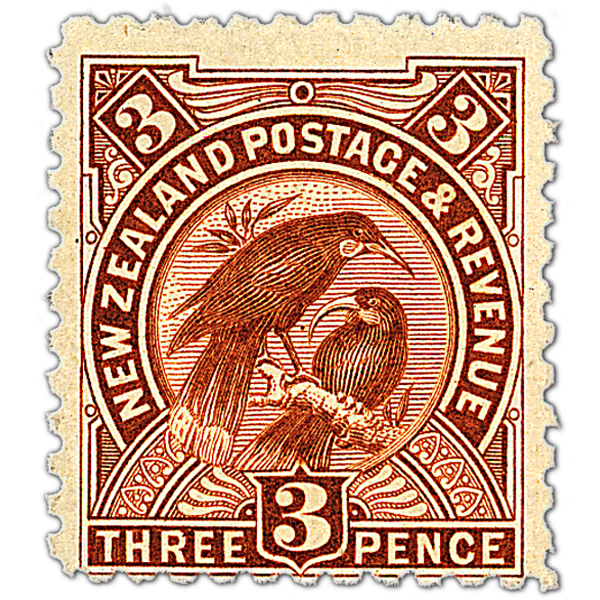 |
Single Stamp |
Single 3d 'Huia' gummed stamp. Huia (Heteralocha acutirostris) became extinct in 1907 as a result of hunting, clearing of their forest habitat and over-zealous specimen collecting for museums. The huia was noted for its green black plumage, its rounded orange wattles and white-tipped tail. The female had a long, slender curving bill which made it easily distinguishable from the male, which had a much shorter but more powerful beak. Almost always seen in pairs, they normally bounded along the ground or from branch to branch, flying only when necessary. Huia tail feathers were greatly prized by the Māori as symbols of rank and used as adornment by chiefs. |
3d |
 |
Single Stamp |
Single 4d 'White Terraces' gummed stamp. View of the White Terraces, Lake Rotomahana. The White Terraces were situated at the north-east corner of Lake Rotomahana, near Rotorua. The hot waters descended to the lake over a series of spreading ledges or hollowed terraces. |
4d |
 |
Single Stamp |
Single 5d 'Otira Gorge' gummed stamp. The Otira gorge is situated in the Southern Alps on the main route from Canterbury to Westland. Inset within the design is Mount Ruapehu (2,797 metres). |
5d |
 |
Single Stamp |
Single 6d 'Kiwi' gummed stamp. Kiwi (Apterygidae) are the most primitive birds found in NZ. They have probably been here for 70 million years and, because they are unique to this country and a highly distinctive family, they have become a national symbol. Like the extinct moa, the kiwi is unable to fly and has no keel on the sternum (breast bone). The birds stand about 31 cm tall, and have a long, sensitive bill to find their food - worms, grubs and ground insects, and fruit fallen from trees to the forest floor. |
6d |
 |
Single Stamp |
Single 8d 'War Canoe and Crown' gummed stamp. Tree ferns are depicted on the left with cabbage palms on the right. |
8d |
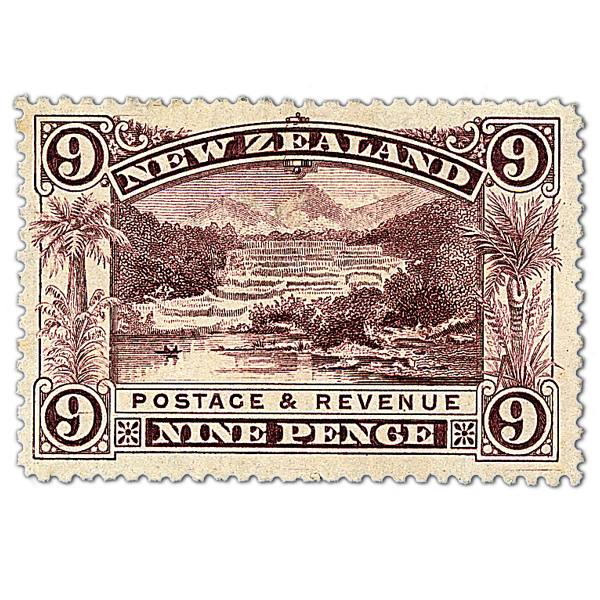 |
Single Stamp |
Single 9d 'Pink Terraces' gummed stamp. The Pink Terraces along with the White Terraces (see 4d stamp) were destroyed when Mount Tarawera erupted on the night of 10 June 1886. An estimated 153 people were killed in the sparsely populated area, and three Māori villages were destroyed. The only records of these scenic phenomena are paintings and photographs taken by some of the thousands of people who went there as tourists. A tree fern is on the left of the design and nikau palm at right. |
9d |
 |
Single Stamp |
Single 1s 'Kea and Kaka' gummed stamp. Kea (Nestor notabilis), on the left, is a parrot about 46 cm long with olive-green feathers and scarlet under wings. It is a bird of great personality, raucous and inquisitive. Kaka (Nestor meridionalis), on the right, is a parrot about 45 cm long, often heard before being seen - its loud, harsh call travelling some distance. Its appearance is striking - bright red-orange neck, abdomen and rump, olive-green above, with scarlet under wings which can be seen when the bird is in flight. |
1s |
 |
Single Stamp |
Single 2s 'Milford Sound' gummed stamp. This region of the South Island has some of the most majestic, unspoilt scenery in the world. Milford is the northernmost of a number of fiords that cut deeply into the coastline, and it is the most spectacular with sheer rock faces soaring 1,200 metres steeply from the sea, backed by mountains as high as 1,900 metres. Mitre Peak (1,695 metres) is depicted on the right of the stamp and cabbage palms at the left. |
2s |
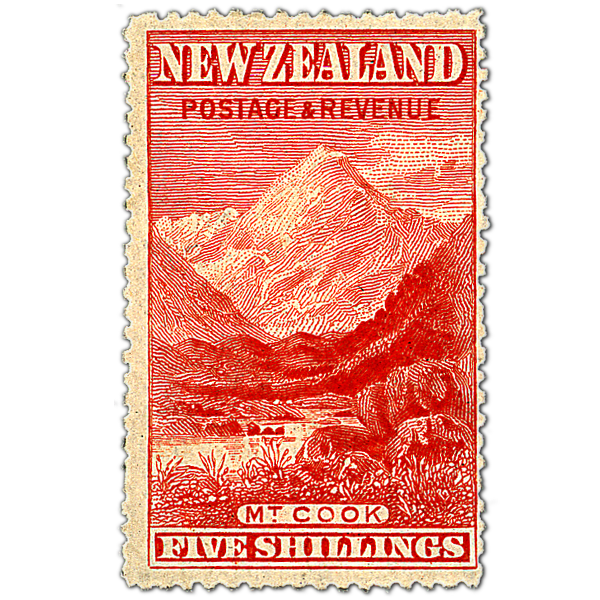 |
Single Stamp |
Single 5s 'Mount Cook' gummed stamp. Mount Cook New Zealand's highest mountain, over 3,700 metres in height, situated in the South Island's Southern Alps. |
5s |
Technical information
| Date of issue: | 4 April 1898 |
|---|---|
| Designers: | H W Young, Auckland; W R Bock, Wellington; J Gaut, Wellington; J Nairn, Wellington and E Howard, Melbourne |
| Printers: | Government Printing Office, New Zealand |
| Stamp sizes: | 1/2d, 1d, 2d, 4d and 1s: 20mm x 24mm; 2 1/2d: 36mm x 22.5mm, 3d, 6d and 8d: 22mm x 26mm; 5d: 22.5mm x 33mm; 9d: 36.5mm x 25mm; 1s and 5s: 36mm x 22.5mm |
| Sheet size: | 240 stamps per sheet, except 2 1/2d and 6d: 120 stamps per sheet and 4d : 80 stamps per sheet |
| Process: | Recess printed - Intaglio |
| Perforation gauge: | Various perforation gauges |
| Paper type: | Cowan chalk surfaced, NZ and star watermark |


